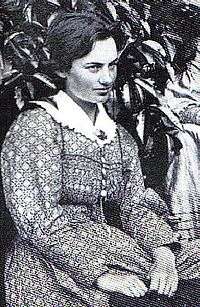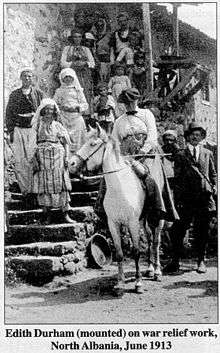Edith Durham
| Edith Durham | |
|---|---|
 | |
| Native name | Mary Edith Durham |
| Born |
8 December 1863 London, United Kingdom |
| Died | 15 November 1944 (aged 80) |
| Academic work | |
| Main interests | Albanian history, Culture |
| Notable works | High Albania |
| Influenced | Robert Elsie |
Mary Edith Durham (8 December 1863 – 15 November 1944) was a British traveller, artist and writer who became famous for her anthropological accounts of life in Albania in the early 20th century.
Early life
Durham was the eldest of nine children; her father, Arthur Edward Durham, was a distinguished London surgeon. She attended Bedford College (1878–82) followed by the Royal Academy of Arts to train as an artist. She exhibited widely and contributed a number of detailed drawings to the amphibia and reptiles volume of the Cambridge Natural History (published 1899).[1]
Balkan expeditions

After the death of her father, Durham took on the responsibilities of caring for her sick mother for several years. It proved an exhausting experience; when she was 37, her doctor recommended that she should undertake a foreign vacation to recuperate. She took a trip by sea down the coast of Dalmatia, travelling from Trieste to Kotor and then overland to Cetinje, the capital of Montenegro. It gave her a taste for southern Balkan life that she was to retain for the rest of her life.
Durham travelled extensively in the Balkans over the next twenty years, focusing particularly on Albania, which then was one of the most isolated and undeveloped areas of Europe. She worked in a variety of relief organisations, painted and wrote, and collected folklore and folk art. Her work was of genuine anthropological significance; she contributed frequently to the journal Man and became a Fellow of the Royal Anthropological Institute. Her writings, however, were to earn her particular fame. She wrote seven books on Balkan affairs, of which High Albania (1909) is the best known. It is still regarded as the pre-eminent guide to the customs and society of the highlands of northern Albania.
Controversy
After her pro-Serb phase, Durham came to identify closely with the Albanian cause and championed the unity and independence of the Albanian people. She earned a reputation as a difficult and eccentric person, and was strongly criticised by - and criticised in turn - advocates of a Yugoslav state, who supported the incorporation of Albanian-populated parts of Kosovo into Yugoslavia. She became increasingly anti-Serb,[2] denouncing what she termed "Serb vermin" for having "not created a Jugoslavia but have carried out their original aim of making Great Serbia .... Far from being liberated the bulk of people live under a far harsher rule than before."
Other, more pro-Serb British intellectuals sharply criticised her views. Rebecca West included Durham in her description of the sort of traveller who came back "with a pet Balkan people established in their hearts as suffering and innocent, eternally the massacree and never the massacrer," (Durham sued West over this)[3] and then went on to say "the Albanians, as championed by Miss Durham, strongly resembled Sir Joshua Reynold's picture of the Infant Samuel."[4][5] The distinguished historian R.W. Seton-Watson commented that "the fact is that while always denouncing 'Balkan mentality', she is herself exactly what she means by the word."[3][note 1]
Albanian views
For their part, however, the Albanians held Durham in high regard. They dubbed her "Mbretëresha e Malësoreve" – the "Queen of the Highlanders." She was well received in the Albanian highlands and passed unmolested despite being a lone female traveller. She benefited from the Albanian tradition of insuring a guest's safety, and from an ancient Albanian custom, the tradition of "Sworn virgins" – women who wore men's clothes and were regarded as protected individuals. When she died in 1944 she received high praise for her work from the exiled King Zog, who wrote: "She gave us her heart and she won the ear of our mountaineers." She is still regarded as something of a national heroine; in 2004, Albanian President Alfred Moisiu described her as "one of the most distinguished personalities of the Albanian world during the last century"[6]
Collections
Much of Durham's work was donated to academic collections following her death. Her papers are held by the Royal Anthropological Institute, London, her diaries are in the Bankfield Museum, Halifax along with her collections of Balkan costume and jewellery given in 1935. Further gifts of mostly Balkan artefacts were given to the British Museum in 1914 and to the Pitt Rivers Museum, Oxford and the Horniman Museum, London.[7]
Notes
- ↑ The The Durham–Seton-Watson correspondence, is housed in the Seton-Walson papers at the School of Slavonic and East European Studies, London.
References
- ↑ Harry Hodgkinson (2004). "Durham, (Mary) Edith (1863–1944)". Oxford Dictionary of National Biography,. Oxford University Press. Retrieved 9 April 2014.
- ↑ Thomas Cushman; Stjepan Mestrovic (1 October 1996). This Time We Knew: Western Responses to Genocide in Bosnia. NYU Press. p. 248. ISBN 978-0-8147-7224-9. Retrieved 30 August 2013.
...Durham turned increasingly anti-Serbian...
- 1 2 King, Charles (4 August 2000). "Queen of the Highlanders: Edith Durham in 'the land of the living past'". Times Literary Supplement: 13–14.
- ↑ Rebecca West (1941). Black Lamb and Grey Falcon: A Journey Through Yugoslavia in 1937. Macmillan.
- ↑ "The Infant Samuel". Tate. Retrieved 9 April 2014.
- ↑ Presidenti i Republikës së Shqiperisë at www.president.al
- ↑ "Miss Mary Edith Durham (Biographical details)". The British Museum. Retrieved 9 April 2014.
Bibliography
| Library resources about Edith Durham |
| By Edith Durham |
|---|
- Through the Lands of the Serb (1904)
- The burden of the Balkans (1905)
- High Albania (1909)
- The struggle for Scutari (1914)
- Twenty Years of Balkan Tangle (1920)
- The Sarajevo Crime (1925)
- Some Tribal Origins, Laws and Customs of the Balkans (1928)
- Albania and the Albanians: selected articles and letters, 1903-1944, ed. by Bejtullah Destani (I.B. Tauris, 2001)
- The Blaze in the Balkans; selected writings, 1903-1941 edited by Robert Elsie and Bejtullah D Destani (I.B. Tauris, 2014)
Further reading
- Mary Edith Durham (2016). Nella Terra del Passato Vivente. La scoperta dell'Albania nell'Europa del primo Novecento. Introduzione, traduzione, note e appendice di Olimpia Gargano. Lecce: Besa. 2016
- Elizabeth Gowing (2013). Edith and I; on the trail of an Edwardian traveller in Kosovo. Elbow Publishing.
- Kastriot Frashëri (2004). Edith Durham : një zonjë e madhe për Shqipërinë. Geer.
- Laura Emily Start (1939). The Durham Collection of Garments and Embroideries from Albania and Jugoslavia. Halifax Corporation
- Gill Trethowan (1996). Queen of the Mountains: The Balkan Adventures of Edith Durham. British Council.
- Christian Medawar (1995). Mary Edith Durham and the Balkans, 1900-1914. McGill University.
- John Hodgson (2000). "Edith Durham, traveller and publicist". In John B. Allcock, Antonia Young. Black Lambs & Grey Falcons: Women Travellers in the Balkans. Berghahn Books. pp. 9–31. ISBN 9781571817440.
External links
- Works by Edith Durham at Project Gutenberg
- Works by or about Edith Durham at Internet Archive
- Works by Edith Durham at The Online Books Page
- Work containing scientific illustrations by Edith Durham
- Works by Edith Durham at Biodiversity Heritage Library
| Wikimedia Commons has media related to Edith Durham. |
